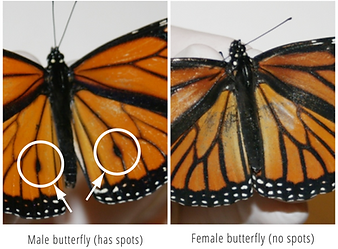
Interested in Testing Monarchs for OE?
If you are interested in testing your local butterflies for the OE parasite and contributing data to our project,
you can request a FREE sampling kit by emailing us your mailing address at monarchhealth@gmail.com.
Testing Monarchs for OE
Can't you tell a monarch is infected just by looking at it?
Not always, as it depends on how heavily infected the monarch is. Many OE infections, especially of eastern North American monarchs, are 'mild' cases, and the infected adult monarch will look and act nearly identical to a healthy adult. Aside from the most severe cases of OE, it is usually impossible to know if a monarch is infected without testing them using the methods described below. Unfortunately, mildly infected adults that appear to be healthy can still spread their spores around their cages and rearing containers, which is why it is essential to test all adult monarchs upon eclosion. If it is suspected that a monarch is infected, remove it from the other monarchs immediately.
Below are some pictures of various OE infected monarchs. Most infected monarchs will appear normal, but if an infection is severe enough, you may be able to see spores forming under the cuticle during the pupal stage, and adults may lack white patterns on their abdomen due to the white scales being obscured by spores. In extremely severe cases, monarchs may eclose with wing deformities or fail to properly eclose at all.





What comes in a sampling kit:
(To download and print instructions and datasheets, click on their images below.)
What you will need (not included in kit):
HYDRA
How to Take an OE Sample
Step 1:
Put on your gloves!

Step 3:
Pick up a sticker using your other hand and gently place the sticky side of the piece of tape to the abdomen of the monarch. Press down so that it wraps around and sticks to the sides of the abdomen.

Step 5:
Label the sticker sample on the spore card with the identity (we use a number) of the monarch. Continue these steps until you have sampled all of your monarchs. In the end, your index cards should look similar to this:
*Note: The numbers on the bottom of each sample refer to the number of the butterfly in our lab, and the numbers above refer to the parasite 'spore load' on each monarch (we use a 0-5 scaling system). You only need to record the number on your datasheet that correlates with the sample.

Step 7:
Record data on data sheet for each butterfly. Please try to include all the data requested on the sheet.
Check out our instructional video if you need help filling out the data sheet!
Step 9:
Prepare the sample for mailing.
Once filled out completely, place the index card into the enclosed, pre-addressed envelope and send it to our lab at the University of Georgia. Samples should be mailed in the envelope provided to:
Project Monarch Health
c/o Sonia Altizer
Odum School of Ecology
University of Georgia
Athens, GA 30602-2202

Step 2:
Hold the monarch firmly as shown in the picture, using a gloved hand. Be sure not to use your other hand to touch the butterfly because that hand will be used to hold the tape sticker and sample for spores.

Step 4:
Gently peel the sticker off and stick it to the index card. You will remove some scales in the process, but don't worry, it will not harm the monarch.

Step 6:
While you have the butterfly out, determine the sex. The two sexes are easy to tell apart because males have a small raised black spot on a vein on each hind wing that is not present in females.

Step 8:
Release butterflies back into the wild once all necessary data has been recorded. Even if you believe that your monarchs are infected, they can be released as long as they reflect the natural disease prevalence (no OE contamination during rearing) and are healthy enough to fly.
Click here for more information on what to do with infected monarchs.

Step 10:
Wipe down your work surface with 20% bleach (estimating a solution of 1/5 bleach and 4/5 water is fine) when you finish and dispose of your gloves before handling another monarch. It's important to try and keep a clean work area when sampling the butterflies for parasites. One monarch may be infected, while another may not. Spores due to contamination on hands, gloves, or surfaces will affect the spore counts on the sample.
Changing gloves and wiping areas with bleach wipes will prevent cross-contamination of different samples and help avoid touching a non-infected sample with infected spores from another.

Are the monarchs I sampled infected?
We will examine each of your samples for the presence of parasite spores. Once we have the results, we will notify you of the infection status via email.
To the right is what a sample looks like when we examine it under the microscope.
The red arrows indicate the parasite spores in this image. The big objects are the monarch scales. The spores look like tiny lemon-shaped objects and often clump together. This monarch would be considered heavily infected.





